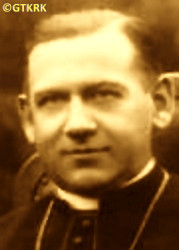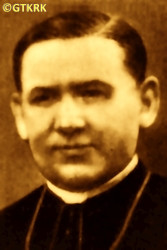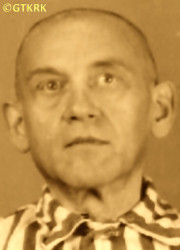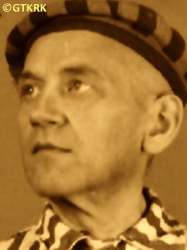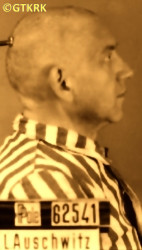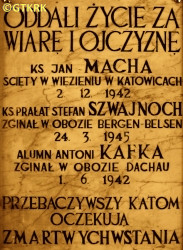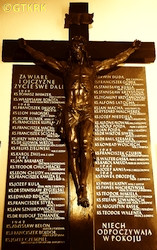Roman Catholic
St Sigismund parish
05-507 Słomczyn
85 Wiślana Str.
Konstancin deanery
Warsaw archdiocese, Poland
full list:
displayClick to display full list

searchClick to search full list by categories
wyświetlKliknij by wyświetlić pełną listę po polsku

szukajKliknij by przeszukać listę wg kategorii po polsku

Martyrology of the clergy — Poland
XX century (1914 – 1989)
personal data
surname
SZWAJNOCH
surname
versions/aliases
SCHWEINOCH
forename(s)
Steven (pl. Stefan)
forename(s)
versions/aliases
Stephen (pl. Szczepan)
function
diocesan priest
creed
Latin (Roman Catholic) Church RCmore on
en.wikipedia.org
[access: 2014.09.21]
diocese / province
Katowice diocesemore on
en.wikipedia.org
[access: 2013.05.19]
Wrocław diocesemore on
en.wikipedia.org
[access: 2013.05.19]
honorary titles
Papal chamberlainmore on
en.wikipedia.org
[access: 2014.11.22]
(1932)
Minor Canonmore on
en.wikipedia.org
[access: 2014.11.14]
(05.1937, St Peter and St Paul the Apostles RC cathedral church, Katowicetoday: Katowice city pov., Silesia voiv., Poland
more on
en.wikipedia.org
[access: 2021.08.12])
Gold „Cross of Merit”more on
en.wikipedia.org
[access: 2019.04.16]
(10.02.1939)
date and place
of death
24.03.1945

KL Bergen‐Belsenconcentration camp
today: n. Bergen, Celle dist., Lower Saxony state, Germany
more on
en.wikipedia.org
[access: 2022.01.09]
details of death
When studying theology in Wrocław collaborated with the clandestine Polish Youth Union „Zet”, part of clandestine National League, main aim of which was independence of Poland.
Was also the last chairman of clandestine „Swoi” (Eng. „Ours”) unit, founded on „Zet” organisation's initiative.
In 1916 moved from a parish in Upper Silesia to a ministry in Berlin — prob. as result of his pro‐Polish stance.
In 1919‐1921, after Poland regained independence in 11.1918, during preparations for a plebiscite that was to decide national destiny of Upper Silesia and Opole region supported his Polish cause. Spoke at rallies and organized work teams for the future Polish state administration. Intervened, as part of a delegation of the Polish clergy of Silesia, with the representative of the Holy See in Poland (prob. Abp Achille Ratii, later the Pope Pius XI).
In 06.1922 — after the plebiscite, which took place on 20.03.1921 — survived an attack by German militia thugs on his Zabrze parish, which as a result of the plebiscite and the division of Upper Silesia remained within the borders of Germany. Moved then to Poland, to Tychy.
After German and Russian invasion of Poland in 09.1939 and start of the World War II, after start of German occupation, his name prob. was included in Gthe one of the so‐called Germ. Sonderfahndungsliste (Eng. Special Wanted List), i.e. a proscription list of names of „enemies of the Reich”, prepared before the German aggression, or on some other proscription list, drawn up ad hoc by the Germ. Volksdeutsche (Eng. Ethnic Germans), i.e. representatives of the German minority in Poland.
Hunted by the Germans.
Arrested on 02.11.1939 and imprisoned in Katowice.
In 02.1940, released, but expelled from Upper Silesia — which the Germans incorporated directly into the Reich, initially to the Germ. Provinz Schlesien (Eng. Province of Silesia) — to the German‐run Germ. Generalgouvernement (Eng. General Governorate).
Initially, from 04 to 08.1940, resided in Kraków. Then became a translator/interpreter in the curia of Kielce diocese and the personal chaplain of Bp Ceslav Kaczmarek.
And in Kielce in 09.1942 arrested by the Germans, „for influencing Germans in a pro‐Polish spirit and spreading defeatist messages”. Supposed to disseminate messages obtained by „illegal radio stations”. In the Germ. Generalgouvernement the possession of radio receivers required a permit from the Germ. Deutsche Post Osten (Eng. German Post Office of the East), which issued them only to people of German nationality and some collaborators. The ban on possessing radio receivers without a permit came into effect on 13.04.1940 — illegal possession of a radio receiver or listening to broadcasts from such a device was considered a crime called radio spoofing, punishable by a prison sentence of at least 6 months, and in practice by sending to German concentration camps, or even death. During the search of his premises, a map was allegedly found on which he was supposed to mark the borders of the future Poland — stretching far to the west.
01.09.1942 transported — perhaps unrecognized as a Catholic priest — to the KL Auschwitz concentration camp. Slaved in the camp hospital as a nurse, and then in the Germ. Kommando (Eng. commando) Bauhof — i.e. the basic cell in the slave labor organization in German concentration camps, responsible for construction warehouses.
In 1944 transported from KL Auschwitz to the KL Sachsenhausen concentration camp.
Finally prob. in a so‐called „death march” taken to KL Bergen‐Belsen concentration camp where perished.
prisoner camp's numbers
62541Click to display source page (KL AuschwitzClick to display the description)
cause of death
extermination: exhaustion
perpetrators
Germans
sites and events
KL Bergen‐BelsenClick to display the description, KL SachsenhausenClick to display the description, KL AuschwitzClick to display the description, KielceClick to display the description, GeneralgouvernementClick to display the description, Katowice (prison)Click to display the description, «Intelligenzaktion Schlesien»Click to display the description, «Intelligenzaktion»Click to display the description, Regierungsbezirk KattowitzClick to display the description, Ribbentrop‐MolotovClick to display the description, Pius XI's encyclicalsClick to display the description, Silesian UprisingsClick to display the description
date and place
of birth
31.08.1886Birth certification on:
photos.szukajwarchiwach.gov.pl
[access: 2025.08.19]

Bielszowicetoday: district of Ruda Śląska, Ruda Śląska city pov., Silesia voiv., Poland
more on
en.wikipedia.org
[access: 2022.01.10]
parents
SZWAJNOCH Francis
🞲 ?, ? — 🕆 ?, ?

GONSIOR Barbara
🞲 ?, ? — 🕆 ?, ?
presbyter (holy orders)
ordination
22.06.1912

Wrocławtoday: Wrocław city pov., Lower Silesia voiv., Poland
more on
en.wikipedia.org
[access: 2021.04.02]
positions held
01.02.1938 – 1940
curatus/rector/expositus — Katowicetoday: Katowice city pov., Silesia voiv., Poland
more on
en.wikipedia.org
[access: 2021.08.12] ⋄ Christ the King RC church ⋄ St Peter and St Paul the Apostles RC cathedral parish ⋄ Katowicetoday: Katowice city pov., Silesia voiv., Poland
more on
en.wikipedia.org
[access: 2021.08.12] RC deanery — also: clerk in the Chancellery of the Bishop Ordinary of the Katowice diocese; member of the Administrative Council (Lat. Consilium Administrationis) in the diocesan Curia; from 20.09.1938 president of the Mission Council in the diocesan Curia; ecclesiastical assistant of the Diocesan Institute of Catholic Action DIAK
1937 – 1940
Minor Canon — Katowicetoday: Katowice city pov., Silesia voiv., Poland
more on
en.wikipedia.org
[access: 2021.08.12] ⋄ Cathedral Chapter ⋄ St Peter and St Paul the Apostles RC cathedral church
01.03.1925 – 1938
parish priest — Chorzówform.: Królewska Huta (till 1934)
today: Chorzów Stary district of Chorzów /from 1934/, Chorzów city pov., Silesia voiv., Poland
more on
en.wikipedia.org
[access: 2010.08.11] ⋄ St Mary Magdalene RC parish ⋄ Chorzówform.: Królewska Huta (till 1934)
today: Chorzów city pov., Silesia voiv., Poland
more on
en.wikipedia.org
[access: 2010.08.11] RC deanery — also: from 21.06.1937 clerk in the Chancellery of the Bishop Ordinary of the Katowice Diocese; from 16.04.1937 ecclesiastical assistant of the Diocesan Institute of Catholic Action DIAK; from 1937 curator and visitor of the Congregation of the Marian Sisters SMI; from 23.03.1931 member of the Administrative Council (Lat. Consilium Administrationis) in the diocesan Curia; director of the diocesan Missionary Union of the Clergy; member of the pro‐synodal diocesan Commission for the Religious Education of Youth; member of the Silesian Council of the Union of Polish Youth Associations; president of the Society of People’s Reading Rooms in Chorzów; vice‐president of the Provincial Board of the Polish Christian Democratic Party; vice‐president of the Silesian Academic Union; from 1931 member of the Silesian Provincial Council; 1930‐1936 editor of the „Chorzowskie Wiadomości Parafialne” (pl. „Chorzów Parish News”)
c. 1923 – 1925
prefect — Królewska Hutatoday: Chorzów /from 1934/, Chorzów city pov., Silesia voiv., Poland
more on
en.wikipedia.org
[access: 2021.12.18] ⋄ St Hedwig of Silesia RC parish ⋄ Królewska Hutatoday: Chorzów /from 1934/, Chorzów city pov., Silesia voiv., Poland
more on
en.wikipedia.org
[access: 2021.12.18] RC deanery — organizer of Polish education (Królewska Huta, as a result of a plebiscite, found itself in Poland); also: from 1923 inspector of primary and secondary schools in the Department of Public Education in Katowice; for a short time director of the State Male Classical Gymnasium in Królewska Huta (later named after Odrowąż family); from 11.1923 member of the Board of the Catholic League
till 1922
parish priest — Zabrzetoday: Zabrze city pov., Silesia voiv., Poland
more on
en.wikipedia.org
[access: 2021.04.02] ⋄ St Anne RC parish ⋄ Zabrzetoday: Zabrze city pov., Silesia voiv., Poland
more on
en.wikipedia.org
[access: 2021.04.02] RC deanery
from 1917
vicar — Kluczborktoday: Kluczbork gm., Kluczbork pov., Opole voiv., Poland
more on
en.wikipedia.org
[access: 2010.08.11] ⋄ Blessed Virgin Mary Help of Christians RC parish ⋄ Bogacicatoday: Kluczbork gm., Kluczbork pov., Opole voiv., Poland
more on
en.wikipedia.org
[access: 2021.04.02] RC deanery
1916 – 1917
vicar — Berlintoday: Berlin state, Germany
more on
en.wikipedia.org
[access: 2020.07.31] ⋄ St Michael RC parish ⋄ Berlintoday: Berlin state, Germany
more on
en.wikipedia.org
[access: 2020.07.31] RC deanery
1912 – 1916
vicar — Królewska Hutatoday: Chorzów /from 1934/, Chorzów city pov., Silesia voiv., Poland
more on
en.wikipedia.org
[access: 2021.12.18] ⋄ St Hedwig of Silesia RC parish ⋄ Królewska Hutatoday: Chorzów /from 1934/, Chorzów city pov., Silesia voiv., Poland
more on
en.wikipedia.org
[access: 2021.12.18] RC deanery
1912
vicar — Chróścicetoday: Dobrzeń Wielki gm., Opole pov., Opole voiv., Poland
more on
en.wikipedia.org
[access: 2021.04.02] ⋄ St Hedwig of Silesia RC parish ⋄ Stare Siołkowicetoday: Popielów gm., Opole pov., Opole voiv., Poland
more on
en.wikipedia.org
[access: 2022.01.12] RC deanery
1908 – 1912
student — Wrocławtoday: Wrocław city pov., Lower Silesia voiv., Poland
more on
en.wikipedia.org
[access: 2021.04.02] ⋄ philosophy and theology, Department of Catholic Theology, University of Wrocław [i.e. University of Wrocław (since 1945) / Frederic Wilhelm University of Silesia (1911‐1945) / Royal University i.e. Breslau Academy (1816‐1911)]
activist — political and social
others related
in death
FLORKOClick to display biography Joseph, GRZĄDKAClick to display biography Hippolytus, MACIERZYŃSKIClick to display biography Paul Augustine, MAKIELAClick to display biography Theodore Francis, ORGANISZCZAKClick to display biography Vladislav
sites and events
descriptions
KL Bergen‐Belsen: Till 1944 KL Bergen‐Belsen was a prisoner‐of‐war camp, in 1944 was changed into the German Germ. Konzentrationslager (Eng. concentration camp) KL, in 1945 in so‐called „death marches” thousands of prisoners from other concentration camps were transferred, approx. 50,000 of them died in Bergen‐Belsen. When the camp on 15.04.1945 was liberated by the British troops c. 13,000 unburied bodies were found together with c. 60,000 inmates, emaciated, starving, without a food or drink for days, suffering from illness and sickness, mainly typhoid. C. 14,000 of them perished in next two months without regaining strength and health. (more on: pl.wikipedia.orgClick to attempt to display webpage
[access: 2012.11.23], en.wikipedia.orgClick to attempt to display webpage
[access: 2014.03.10])
KL Sachsenhausen: In Germ. Konzentrationslager (Eng. concentration camp) KL Sachsenhausen, set up in the former Olympic village in 07.1936, hundreds of Polish priests were held in 1940, before being transported to KL Dachau. Some of them perished in KL Sachsenhausen. Murderous medical experiments on prisoners were carried out in the camp. In 1942‐1944 c. 140 prisoners slaved at manufacturing false British pounds, passports, visas, stamps and other documents. Other prisoners also had to do slave work, for Heinkel aircraft manufacturer, AEG and Siemens among others. On average c. 50,000 prisoners were held at any time. Altogether more than 200,000 inmates were in jailed in KL Sachsenhausen and its branched, out of which tens of thousands perished. Prior to Russian arrival mass evacuation was ordered by the Germans and c. 80,000 prisoners were marched west in so‐called „death marches” to other camps, i.e. KL Mauthausen‐Gusen and KL Bergen‐Belsen. The camp got liberated on 22.04.1945. After end of armed hostilities Germans set up there secret camp for German prisoners and „suspicious” Russian soldiers. (more on: en.wikipedia.orgClick to attempt to display webpage
[access: 2018.11.18])
KL Auschwitz: German Germ. Konzentrationslager (Eng. concentration camp) KL and Germ. Vernichtungslager (Eng. extermination camp) VL Auschwitz was set up by Germans around 27.01.1940 n. Oświęcim, on the German territory (initially in Germ. Provinz Schlesien — Silesia Province; and from 1941 Germ. Provinz Oberschlesien — Upper Silesia Province). Initially mainly Poles were interned. From 1942 it became the centre for holocaust of European Jews. Part of the KL Auschwitz concentration camps’ complex was Germ. Vernichtungslager (Eng. extermination camp) VL Auschwitz II Birkenau, located not far away from the main camp. There Germans murdered likely in excess of million people, mainly Jews, in gas chambers. In KL Auschwitz alone, the Germans murdered c. 30,000 prisoners by lethal injection. Until 1941, people were killed by intravenous injections of concentrated hydrogen peroxide, ether, hydrogen peroxide, or gasoline. Later, an intracardiac injection was used — with a needle about 10 cm long — of 10‐15 ml of a 30% solution of phenol C6H5OH (acquired from the German concern IG Farben, or more precisely from its subsidiary Bayer, and still used by Bayer AG, among others, for the production of aspirin), which killed within 15 seconds. Altogether In excess of 400 priests and religious went through the KL Auschwitz, c. 40% of which were murdered (mainly Poles). (more on: en.auschwitz.org.plClick to attempt to display webpage
[access: 2012.11.23], www.meczennicy.pelplin.plClick to attempt to display webpage
[access: 2013.07.06])
Kielce: The prison at Zamkowa Str. in Kielce was opened in 1826‐1828. In 09.1939, after start of German occupation, under German control. Initially a POW camp and next prison run by German political police Gestapo. Till 1945 more then c. 16,000 prisoners were held there. Any time c. 2,000 were incarcerated, in space build for c. 400 people. Prisoners, in extremely cramped conditions, were starved, ill‐treated and murdered in prison, executed outside, transported to German concentration camps or deported to slave labour sites. Prison chapel Germans used as torture chamber. At the same time in 08.1941 (after German attack on 22.06.1941 of their erstwhile ally, Russians, do till the autumn of 1944 in Fijałkowski’s barracks in Kielce Bukówka district Germans set up a POW camp for Russian prisoners (branch of Stalag XII C „Kamienna” in Skarżysko‐Kamienna, later of Stalag 367 Częstochowa). According to one of the witnesses first 100 POWs were brought in 09.1941. A week later 4,500 more arrived and within a fortnight another 5,000. Following that the POWs were brought in groups of 500‐1,000. Altogether c. 15,000‐20,000 Russian POWs were held in the camp. POWs slaved at forest clearances, digging sewage ditches, at train loading. They got a hunger rations (as a result acts of cannibalism took place). Slept in unheated barracks. Were beaten and tortured (with wooden battons). Received to medical help. For any type of transgression they were penalized with execution. The camp was managed by the Germans and was supported by a camp’s militia, composed mainly by the Ukrainians. Only few hundred prisoners survived who in the autumn of 1944 were transferred to other camps. From 1945 in Russian Commie‐Nazi hands. Till 1956 many political prisoners, e.g. members of former restistance Home Army AK and National Armed Forces NSZ (part of Polish Clandestine State) where held camptive there. On 04‐05.1945 Polish partisans commanded by Mjr Anthony Heda attacked the prison and release c. 700 prisoners. (more on: www.chroniclesofterror.plClick to attempt to display webpage
[access: 2020.02.08])
Generalgouvernement: After the Polish defeat in the 09.1939 campaign, which was the result of the Ribbentrop‐Molotov Pact and constituted the first stage of World War II, and the beginning of German occupation in part of Poland (in the other, eastern part of Poland, the Russian occupation began), the Germans divided the occupied Polish territory into five main regions. In two of them new German provinces were created, two other were incorporated into other provinces. However, the fifth part was treated separately, and in a political sense it was supposed to recreate the German idea from 1915 (during World War I, after the defeat of the Russians in the Battle of Gorlice in 05.1915) of creating a Polish enclave within Germany. Illegal in the sense of international law, i.e. Hague Convention, and public law, managed by the Germans according to separate laws — especially established for the Polish Germ. Untermenschen (Eng. subhumans) — till the Russian offensive in 1945 it constituted part of the Germ. Großdeutschland (Eng. Greater Germany). Till 31.07.1940 formally called Germ. Generalgouvernement für die besetzten polnischen Gebiete (Eng. General Government for the occupied Polish lands) — later simply Germ. Generalgouvernement (Eng. General Governorate), as in the years 1915‐1918. From 07.1941, i.e. after the German attack on 22.06.1941 against the erstwhile ally, the Russians, it also included the Galicia district, i.e. the Polish pre‐war south‐eastern voivodeships. A special criminal law was enacted and applied to Poles and Jews, allowing for the arbitrary administration of the death penalty regardless of the age of the „perpetrator”, and sanctioning the use of collective responsibility. After the end of the military conflict of the World War UU, the government of the Germ. Generalgouvernement was recognized as a criminal organization, and its leader, governor Hans Frank, guilty of war crimes and crimes against humanity and executed. (more on: en.wikipedia.orgClick to attempt to display webpage
[access: 2024.12.13])
Katowice (prison): Detention centre run by Germans and later, in 1945, took over by the Commie‐Nazis.
«Intelligenzaktion Schlesien»: A planned action of arrests and extermination of Polish Upper Silesia intellectual elite in general recorded in of the so‐called Germ. Sonderfahndungsliste (Eng. Special Wanted List), i.e. a proscription list of names of „enemies of the Reich” — participants of Upper Silesia uprisings, former Polish plebiscite activists, journalists, politicians, intellectuals, civil servants, priests — organised by Germans mainly in 04‐05.1940, aiming at total Germanisation of the region. The relevant decree, no IV‐D2‐480/40, was issued by the RSHA, i.e. Germ. Reichssicherheitshauptamt (Eng. Reich Security Office), and signed by Heinrich Himmler or Reinhard Heydrich. Some of those arrested were murdered in mass executions, some were deported to the German‐run Germ. Generalgouvernement (Eng. General Governorate), and some were sent to concentration camps. The personal details of 3,047 people deported within two months of 1940 were established. Among the victims were 33 Catholic priests, 22 of whom perished in concentration camps (the clergy were sent — in 5 transports — first to KL Dachau, and then to KL Gusen, where they slaved in quarries). Altogether, the Germans murdered c. 2,000 members of the Polish Upper Silesia intellectual elite. (more on: pl.wikipedia.orgClick to attempt to display webpage
[access: 2016.05.30])
«Intelligenzaktion»: German: «Intelligenzaktion» (English: „Intelligence Action”) — a German program of extermination of the Polish elite, mainly the intelligentsia and leadership layers, carried out from the beginning of the occupation in w 09.1939 to 04.1940, mainly in territories directly annexed to Germany, but also in the so‐called Germ. Generalgouvernement (Eng. General Governorate), where it was called «AB‐aktion». In the first phase, immediately after the beginning of the German occupation, during military operations carried out by the Germ. Wehrmacht (Eng. Armed Forces) and the genocidal units of the Germ. Einsatzgruppen (Eng. Operational Groups) of the Germ. Sicherheitspolizei (Eng. Security Police), i.e. SiPo, and Germ. Sicherheitsdienst des Reichsführers SS (Eng. Security Service of the Reichsführer SS), i.e. SD, organized by the Germ. Reichssicherheitshauptamt (Eng. Reich Main Security Office), i.e. RSHA, which followed the troops, carried out under the Germ. Unternehmen „Tannenberg” (Eng. Operation „Tannenberg”) — based on the so‐called Germ. Sonderfahndungsliste (Eng. Special Wanted Lists), i.e. proscription lists of Poles considered particularly dangerous to the Third Reich, prepared by the Zentralstelle II/P (Polen) unit of the German RSHA. Later, implemented by the German civilian occupation authorities and the genocidal unit of the Germ. Volksdeutscher Selbstschutz (Eng. Ethnic Germans Self‐Defense), whose members were Germ. Volksdeutsche (Eng. Ethnic Germans), i.e. representatives of the German minority in Poland. According to various sources, these lists, at the beginning of 09.1939, could have contained the details of 61,000—88,000 „dangerous” Poles — although these figures cannot be confirmed. In total, during this genocide, c. 50,000 teachers, Catholic priests, representatives of the landed gentry, freelancers, social and political activists, and retired military personnel were systematically and methodically murdered. Another 50,000 were sent to concentration camps, where only a negligible percentage survived. (more on: en.wikipedia.orgClick to attempt to display webpage
[access: 2014.10.04])
Regierungsbezirk Kattowitz: After the Polish defeat in the 09.1939 campaign, which was the result of the Ribbentrop‐Molotov Pact and constituted the first stage of World War II, and the beginning of German occupation in part of Poland (in the other, eastern part of Poland, the Russian occupation began), the Germans divided the occupied Polish territory into five main regions (and a few smaller). The largest one was transformed into Germ. Generalgouvernement (Eng. General Governorate), intended exclusively for Poles and Jews and constituting part of the so‐called Germ. Großdeutschland (Eng. Greater Germany). From two separate new provinces were created. The two remaining were incorporated into existing German provinces. One of those was Polish Upper Silesia, which on 08.09.1939, by decree of the German leader Adolf Hitler (formally came into force on 26.10.1939), was incorporated into Germany as the Germ. Regierungsbezirk Kattowitz (Eng. Katowice Regency) and became part of the Germ. Provinz Schlesien (Eng. Province of Silesia) based in Wrocław. On 01.04.1940, the Germ. Regierungsbezirk Kattowitz was enlarged by several pre‐war German counties, and on 18.01.1941, a new German province was created, the Germ. Provinz Oberschlesien (Eng. Province of Upper Silesia), which, apart from the Germ. Regierungsbezirk Kattowitz, also included the Opole region. From 26.10.1939, when the regency was established, the law of the German state was in force there, the same as in Berlin. The main axis of the policy of the new regency, the territory of which the Germans recognized as the Germ. „Ursprünglich Deutsche” (Eng. „natively German”), despite the fact only 6% of its pre–war Polish part were Germans, was Germ. „Entpolonisierung” (Eng. „Depolonisation”), i.e. forced Germanization. The main mechanism was the introduction of the Germ. Deutsche Volksliste DVL, a German nationality list that was supposed to specify the national affiliation of the inhabitants of the region. The largest group marked in the compulsory registrations was Group 3, people who identified themselves as „Silesians” (in 1943 about 41%), and people remaining outside the DVL (about 36%). The latter group was intended to be deported to the Germ. Generalgouvernement (which did not happen en masse because German industry needed slave labor). Group 3, considered by the Germans as capable of Germanization, was subject to certain legal restrictions, and was subject to, among others, to conscription into the German Wehrmacht army. Children could only learn in German. A policy of terror was pursued against the Polish population. There was a special police court, controlled by the Germ. Geheime Staatspolizei (Eng. Secret State Police), i.e. the Gestapo, before which c. 4,000‐5,000 people were detained. For the years 1942‐1945 over 2,000 of them were verified, of which 1,890 were sentenced to death, including 286 in public executions. Thousands of people were murdered during the so‐called «Intelligenzaktion Schlesien», including 300‐650 Polish teachers and c. 61 Polish Catholic priests. The regency hosted a German concentration and extermination camp KL Auschwitz, where the Germans imprisoned c. 1,100,000 Jews (murdering c.1,000,000, i.e. c. 90% of them) and c. 140,000 Poles (murdering c. 70,000, i.e. c. 50% of them). After the end of hostilities of World War II, the overseer of this province, the Germ. Reichsstatthalter (Eng. Reich Governor) and the Germ. Gauleiter (Eng. district head) of the German National Socialist Party, Fritz Brecht, committed suicide. (more on: en.wikipedia.orgClick to attempt to display webpage
[access: 2024.06.24])
Ribbentrop‐Molotov: Genocidal Russian‐German alliance pact between Russian leader Joseph Stalin and German leader Adolf Hitler signed on 23.08.1939 in Moscow by respective foreign ministers, Mr. Vyacheslav Molotov for Russia and Joachim von Ribbentrop for Germany. The pact sanctioned and was the direct cause of joint Russian and German invasion of Poland and the outbreak of the World War II in 09.1939. In a political sense, the pact was an attempt to restore the status quo ante before 1914, with one exception, namely the „commercial” exchange of the so‐called „Kingdom of Poland”, which in 1914 was part of the Russian Empire, fore Eastern Galicia (today's western Ukraine), in 1914 belonging to the Austro‐Hungarian Empire. Galicia, including Lviv, was to be taken over by the Russians, the „Kingdom of Poland” — under the name of the General Governorate — Germany. The resultant „war was one of the greatest calamities and dramas of humanity in history, for two atheistic and anti‐Christian ideologies — national and international socialism — rejected God and His fifth Decalogue commandment: Thou shall not kill!” (Abp Stanislav Gądecki, 01.09.2019). The decisions taken — backed up by the betrayal of the formal allies of Poland, France and Germany, which on 12.09.1939, at a joint conference in Abbeville, decided not to provide aid to attacked Poland and not to take military action against Germany (a clear breach of treaty obligations with Poland) — were on 28.09.1939 slightly altered and made more precise when a treaty on „German‐Russian boundaries and friendship” was agreed by the same murderous signatories. One of its findings was establishment of spheres of influence in Central and Eastern Europe and in consequence IV partition of Poland. In one of its secret annexes agreed, that: „the Signatories will not tolerate on its respective territories any Polish propaganda that affects the territory of the other Side. On their respective territories they will suppress all such propaganda and inform each other of the measures taken to accomplish it”. The agreements resulted in a series of meeting between two genocidal organization representing both sides — German Gestapo and Russian NKVD when coordination of efforts to exterminate Polish intelligentsia and Polish leading classes (in Germany called «Intelligenzaktion», in Russia took the form of Katyń massacres) where discussed. Resulted in deaths of hundreds of thousands of Polish intelligentsia, including thousands of priests presented here, and tens of millions of ordinary people,. The results of this Russian‐German pact lasted till 1989 and are still in evidence even today. (more on: en.wikipedia.orgClick to attempt to display webpage
[access: 2015.09.30])
Pius XI's encyclicals: Facing the creation of two totalitarian systems in Europe, which seemed to compete with each other, though there were more similarities than contradictions between them, Pope Pius XI issued in 03.1937 (within 5 days) two encyclicals. In the „Mit brennender Sorge” (Eng. „With Burning Concern”) published on 14.03.1938, condemned the national socialism prevailing in Germany. The Pope wrote: „Whoever, following the old Germanic‐pre‐Christian beliefs, puts various impersonal fate in the place of a personal God, denies the wisdom of God and Providence […], whoever exalts earthly values: race or nation, or state, or state system, representatives of state power or other fundamental values of human society, […] and makes them the highest standard of all values, including religious ones, and idolizes them, this one […] is far from true faith in God and from a worldview corresponding to such faith”. On 19.03.1937, published „Divini Redemptoris” (Eng. „Divine Redeemer”), in which criticized Russian communism, dialectical materialism and the class struggle theory. The Pope wrote: „Communism deprives man of freedom, and therefore the spiritual basis of all life norms. It deprives the human person of all his dignity and any moral support with which he could resist the onslaught of blind passions […] This is the new gospel that Bolshevik and godless communism preaches as a message of salvation and redemption of humanity”… Pius XI demanded that the established human law be subjected to the natural law of God , recommended the implementation of the ideal of a Christian state and society, and called on Catholics to resist. Two years later, National Socialist Germany and Communist Russia came together and started World War II. (more on: www.vatican.vaClick to attempt to display webpage
[access: 2023.05.28], www.vatican.vaClick to attempt to display webpage
[access: 2023.05.28])
Silesian Uprisings: Three armed interventions of the Polish population against Germany in 1919‐1921 aiming at incorporation of Upper Silesia and Opole region into Poland, after the revival of the Polish state in 1918. Took place in the context of a plebiscite ordered on the basis of the international treaty of Versailles of 28.06.1919, ending the First World War, that was to decide national fate of the disputed lands. The 1st Uprising took place on 16‐24.08.1919 and broke out spontaneously in response to German terror and repression against the Polish population. Covered mainly Pszczyna and Rybnik counties and part of the main Upper Silesia industrial district. Suppressed by the Germans. 2nd Uprising took place on 19‐25.08.1920 in response to numerous acts of terror of the German side. Covered the entire area of the Upper Silesia industrial district and part of the Rybnik county. As a result Poles obtained better conditions for the campaign prior the plebiscite. The poll was conducted on 20.03.1921. The majority of the population — 59.6% — were in favor of Germany, but the results were influenced by the admission of voting from former inhabitants of Upper Silesia living outside Silesia. As a result the 3rd Uprising broke out, the largest such uprising of the Silesian in the 20th century. It lasted from 02.05.1921 to 05.07.1921. Spread over almost the entire area of Upper Silesia. Two large battles took place in the area of St. Anna Mountain and near Olza. As a result on 12.10.1921 the international plebiscite commission decided on a more favorable for Poland division of Upper Silesia. The territory granted to Poland was enlarged to about ⅓ of the disputed territory. Poland accounted for 50% of metallurgy and 76% of coal mines. (more on: en.wikipedia.orgClick to attempt to display webpage
[access: 2020.05.25])
sources
personal:
encyklo.plClick to attempt to display webpage
[access: 2021.12.19], pl.wikipedia.orgClick to attempt to display webpage
[access: 2016.05.30], photos.szukajwarchiwach.gov.plClick to attempt to display webpage
[access: 2025.08.19]
original images:
encyklo.plClick to attempt to display webpage
[access: 2016.05.30], www.alamy.comClick to attempt to display webpage
[access: 2023.08.22], www.auschwitz.orgClick to attempt to display webpage
[access: 2018.11.18], www.auschwitz.orgClick to attempt to display webpage
[access: 2018.11.18], www.auschwitz.orgClick to attempt to display webpage
[access: 2018.11.18], commons.wikimedia.orgClick to attempt to display webpage
[access: 2019.12.01]
LETTER to CUSTODIAN/ADMINISTRATOR
If you have an Email client on your communicator/computer — such as Mozilla Thunderbird, Windows Mail or Microsoft Outlook, described at WikipediaPatrz:
en.wikipedia.org, among others — try the link below, please:
LETTER to CUSTODIAN/ADMINISTRATORClick and try to call your own Email client
If however you do not run such a client or the above link is not active please send an email to the Custodian/Administrator using your account — in your customary email/correspondence engine — at the following address:

giving the following as the subject:
MARTYROLOGY: SZWAJNOCH Steven
To return to the biography press below:
 Click to return to biography
Click to return to biography








